Two sinusoidal waves with the same amplitude and wavelength travel through each other along a string that is stretched along an x axis. Their resultant wave is shown twice in Fig. 16-53, as the antinode A travels from an extreme upward displacement to an extreme downward displacement in 6.0 ms. The tick marks along the axis are separated by 15 cm, height H is 1.20 cm. Let the equation for one of the two waves be of the form y(x,t)=ymsin(kx+ω). In the equation for the other wave, what are (a)ym(b)k,(c)ω, and (d) the sign in front of ω? 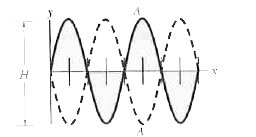
The correct Answer is:(a) 3.0 mm; (b) 10.47m−1; (c) 5.2×102 rad/s (d) minus sign
Topper's Solved these Questions
- WAVES-IBOOK - RESNICK AND HALLIDAYCHAPTER - WAVES-IEXERCISE - Practice Questions (Single Correct Choice Type)
33 Videos
- WAVES-IBOOK - RESNICK AND HALLIDAYCHAPTER - WAVES-IEXERCISE - Practice Questions (More than One Coorect Choice Type)
10 Videos
- WAVES-IBOOK - RESNICK AND HALLIDAYCHAPTER - WAVES-IEXERCISE - Checkpoint
8 Videos
- WAVE - IIBOOK - RESNICK AND HALLIDAYCHAPTER - WAVE - IIEXERCISE - PRACTICE QUESTIONS (INTEGER TYPE)
5 Videos
- WORK, POWER, AND ENERGYBOOK - RESNICK AND HALLIDAYCHAPTER - WORK, POWER, AND ENERGYEXERCISE - PRACTICE QUESTIONS (Integer Type)
5 Videos
Similar Questions
Two sinusoidal waves with the same amplitude of 6.00 mm and the same wavelength travel together along a string that is stretched along an x axis. Their resultant wave is shown twice in Fig. 16 39. as velley travels in the negative direction of the x axis by distance d= 56.0 cm in 8.0 ms. The lick matks along the axis are separated by 10cm, and height H is 8.0mm. Let the equation for one wive be of the form y(x,t) =ymsin(kx±ωt+ϕ1), where ϕ1=0 and you must choose the correct sign in front of ω. For the equation for the other wave, what are (a) ym,(b)k,(c)ω,(d)ϕ2, and (e) the sign in front of ω?
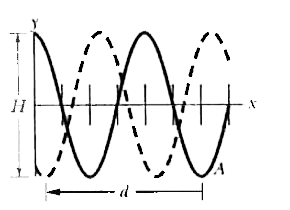
View SolutionIn Fig 16-46, a sinusoidal wave moving along a string is shown twice as crest A travels in the positive direction of any x axis by distance d=6.0 cm in 3.0 ms. The tick marks along the axis are separated by 10cm, height H=6.00MM. The equation for the wave is in the form y(x,t) =ymsin(kx±ωt). so what are (a) ym,(b)k,(c)ω and (d) the correct choice of sign in front of ω?
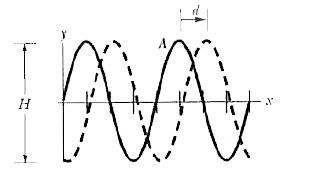
View Solution
Knowledge Check

A sinusoidal wave moving along a string is shown twice in the figure. As crest A travels in the positive direction of an x axis by distance d=6.0 cm in 4.0m. The tick marks along the axis are separated by 10cm, height H=6.00mm. The wave equation isAy=(3mm)sin[16x−2.4×102t]By=(3mm)sin[16x+2.4×102t]Cy=(3mm)sin[8x+2.4×102t]Dy=(3mm)sin[8x−2.4×102t]Two sinusoidal waves with same wavelengths and amplitudes travel in opposite directions along a string with a speed 10ms−1. If the minimum time interval between two instant when the string is flat is 0.5s, the wavelength of the waves is
A25mB20mC15mD10mA transever sine wave of amplitude 10 cm and wavelength 200 cm travels from left to right along a long horizontal stretched, string is at the origin and is moving downward. Then the equation of the wave will be ( in CGS system )
Ay=10sin(0.01π×−πt)By=10sin(πt−0.01π×)Cy=10sin(0.02π×−0.01πt)Dy=10sin(πt−0.02π×)

A sinusoidal wave moving along a string is shown twice in the figure. As crest A travels in the positive direction of an x axis by distance d=6.0 cm in 4.0ms. The tick marks along the axis are separated by 10cm, height H=6.00mm. The wave equation is
View SolutionTwo sinusoidal waves with the same amplitude of 4.0mm and the same wavelength traveled together along a string that is stretched along an x axis, the resultant wave due to their interference was recorded on video tape. The curves in Fig. 16-20 represent the resultant wave in two freeze frames, first as the solid curve and then, 1.0 ms later, as the dotted curve. The grid lines along the x axis are 1.0 cm apart, and the string clements oscillated vertically (perpendicular to the x axis) by 6.0 mm as the resultant wave passed through them. That wave moved a distance d =4.20 cm to the right in the 1.0 ms time interval. Write equations for the two interfering waves and for their resultant wave.
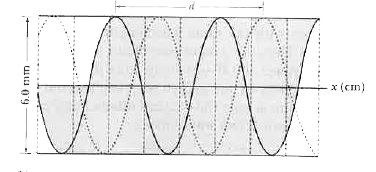
Figure 16-20 The resultant wave of two sinusoidal string wave traveling along an x axis is shown at two instants, between which the resultant wave travels distance d.
View SolutionTwo sinusoidal waves with the same amplitude and wavelength travel along a string that is stretched along an x axis, the resultant wave due to their superposition was recorded on video tape. The curves in Fig. 16-31 represent the resultant wave in four freeze frames in the sequence of a, b, c, and d, with 1.0 ms elapsing between curves a and d. The grid lines along the x axis are 1.0 cm apart, and the string elements oscillated perpendicular to the r axis by 16.0 mm (between the extreme displacements shown by curves a and d) as the resultant wave passed through them. Write equations for the two superposition waves and for their resultant wave.
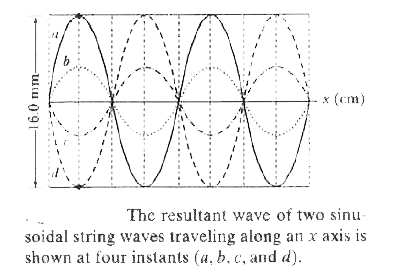
View SolutionTwo sinusoidal waves with identical wavelengths and amplitudes travel in opposite directions along a string with a speed of 15 cm/s. If the time interval between instants when the string is fiat is 0.20 s, what is the wavelength of the waves?
View SolutionTwo sinusoidal waves with same wavelengths and amplitudes travel in opposite directions along a string with a speed 10ms−1. If the minimum time interval between two instant when the string is flat is 0.5s, the wavelength of the waves is
View Solution
